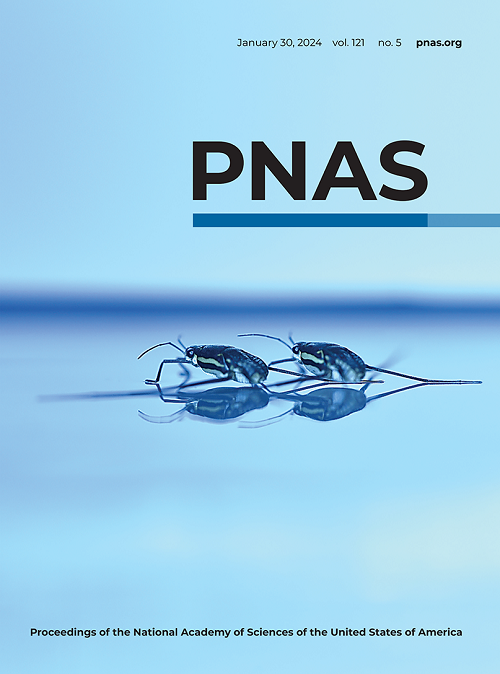昼夜节律时钟基因的非规范作用通过野毛蛾的NuA4/TIP60复合体控制冬季滞育进入。
IF 9.4
1区 综合性期刊
Q1 MULTIDISCIPLINARY SCIENCES
Proceedings of the National Academy of Sciences of the United States of America
Pub Date : 2025-07-10
DOI:10.1073/pnas.2510550122
引用次数: 0
摘要
为了适应季节变化,许多动物,尤其是昆虫,进入一种类似休眠的状态,称为滞育,这主要是通过感知光周期信号来完成的。生物钟由正向调节因子clock (CLK)和周期(CYC)以及负向调节因子Period和Timeless驱动,被认为介导了这种反应。然而,目前尚不清楚滞育诱导是否涉及规范的节律机制,还是独立于它们在计时中的传统作用。以瓢虫黑毛瓢虫(Harmonia axyridis)为模型,研究人员发现,Clk和cyc基因的敲低,而不是per或time基因的敲低,会破坏进入生殖滞育的过程。这一发现表明,Clk-cyc对滞育的调节不依赖于个体数量和时间。我们进一步发现DNA甲基转移酶1相关蛋白1 (DMAP1)介导的H4 (NuA4)/TIP60组蛋白乙酰转移酶复合体的核小体乙酰转移酶通过同时作为CLK-CYC的下游效应物和物理相互作用物影响滞育调节。幼虫激素(JH)受体激动剂methoprene的应用有效地挽救了Clk、cyc和dmap1敲低引起的滞育表型,突出了Clk - cyc - nua4 /TIP60复合物在JH产生中的核心作用。此外,研究人员利用黑腹果蝇(Drosophila melanogaster)的一种ala特异性驱动因子,证明了这种复合物在CA中起局部作用,介导JH的生物合成。总的来说,我们的研究发现了一个以前未被认识的途径,通过该途径,昼夜节律钟蛋白与表观遗传调节剂相互作用,特异性地控制关键内分泌组织中的JH生物合成,从而独立于规范的昼夜节律钟机制调节滞育进入。本文章由计算机程序翻译,如有差异,请以英文原文为准。
Noncanonical action of circadian clock genes controls winter diapause entry via the NuA4/TIP60 complex in Harmonia axyridis.
To adapt to seasonal changes, many animals, particularly insects, enter a dormancy-like condition known as diapause, which is primarily accomplished by sensing photoperiodic signals. The circadian clock, which is driven by positive regulators Clock (CLK) and Cycle (CYC), and negative regulators Period and Timeless, is thought to mediate this response. However, it remains unclear whether diapause induction involves a canonical rhythmic mechanism or occurs independently of their traditional roles in timekeeping. Using the ladybug Harmonia axyridis as a model for short-day-induced winter diapause, we demonstrate that knockdown of Clk and cyc, but not per or tim, disrupted entry into reproductive diapause. This finding demonstrated that Clk-cyc regulates diapause independently of per and tim. We further show that the DNA methyltransferase 1-associated protein 1 (DMAP1)-mediated Nucleosome Acetyltransferase of H4 (NuA4)/TIP60 histone acetyltransferase complex impinges on diapause regulation by acting simultaneously as a downstream effector and a physical interactor of CLK-CYC. Application of the juvenile hormone (JH) receptor agonist methoprene effectively rescued the diapause phenotypes caused by Clk, cyc, and dmap1 knockdowns, highlighting the central role of the CLK-CYC-NuA4/TIP60 complex in JH production. Additionally, using a corpora allata (CA)-specific driver in Drosophila melanogaster, we demonstrate that this complex functions locally in the CA to mediate JH biosynthesis. Collectively, our findings identify a previously unrecognized pathway by which circadian clock proteins interact with an epigenetic regulator to specifically govern JH biosynthesis in a critical endocrine tissue, thereby regulating diapause entry independently of canonical circadian clock mechanisms.
求助全文
通过发布文献求助,成功后即可免费获取论文全文。
去求助
来源期刊
CiteScore
19.00
自引率
0.90%
发文量
3575
审稿时长
2.5 months
期刊介绍:
The Proceedings of the National Academy of Sciences (PNAS), a peer-reviewed journal of the National Academy of Sciences (NAS), serves as an authoritative source for high-impact, original research across the biological, physical, and social sciences. With a global scope, the journal welcomes submissions from researchers worldwide, making it an inclusive platform for advancing scientific knowledge.

 求助内容:
求助内容: 应助结果提醒方式:
应助结果提醒方式:


